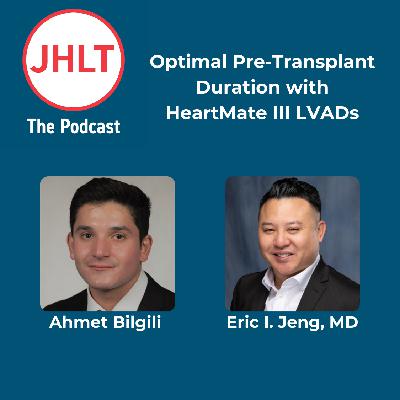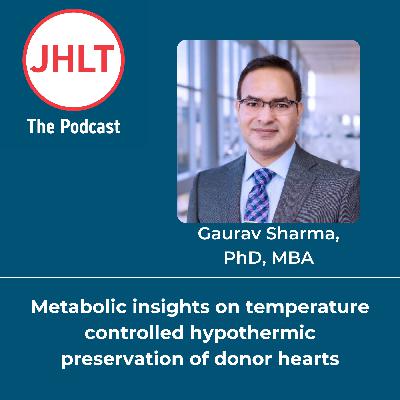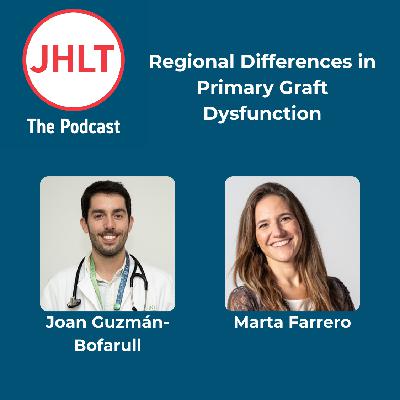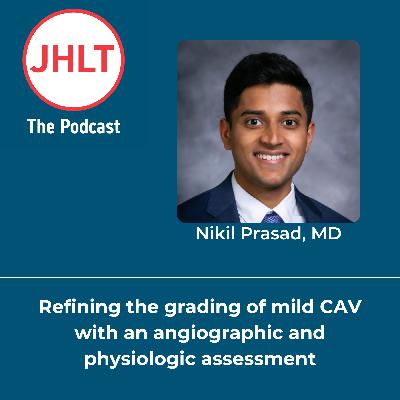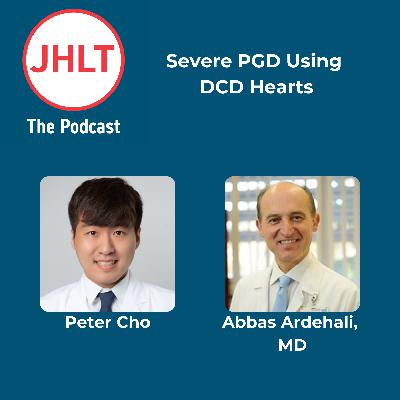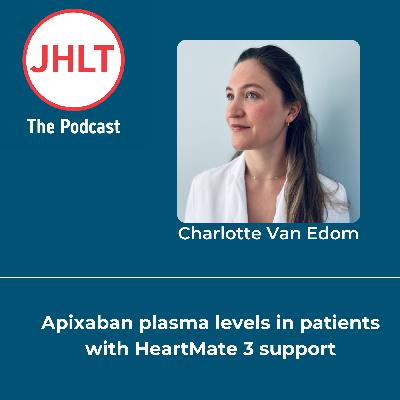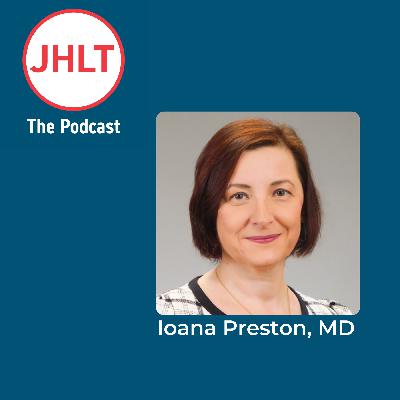Discover JHLT: The Podcast
JHLT: The Podcast

70 Episodes
Reverse
On this episode of JHLT: The Podcast, the Digital Media Editors invite first author Ahmet Bilgili, from the University of Florida’s Congenital Heart Center, and senior author Eric I. Jeng, MD, from the University of Florida’s MCS program. Bilgili and Dr. Jeng discuss their paper, “Optimal pretransplant duration with HeartMate III left ventricular assist device: A contemporary analysis.” The discussion explores: Prior gaps in the literature regarding contemporary HM3 outcomes in relation to transplantation—and the study's potential influence on policy Which length of HM3 support influenced better post-transplant outcomes—and which ages were most influenced How these findings might change standard practice For the latest studies from JHLT, visit www.jhltonline.org/current, or, if you’re an ISHLT member, access your Journal membership at www.ishlt.org/jhlt. Don’t already get the Journal and want to read along? Join the International Society of Heart and Lung Transplantation at www.ishlt.org for a free subscription, or subscribe today at www.jhltonline.org.
On this episode of JHLT: The Podcast, the Digital Media Editors invite first author Luke Williams, a cardiothoracic surgery trainee at Royal Papworth Hospital, NHS Blood and Transplant Clinical Research Fellow, and a PhD student at Cambridge University in the UK. Luke discusses his paper, “The United Kingdom’s experience of controlled donation after circulatory death direct procurement of lungs with concomitant abdominal normothermic regional perfusion with an analysis of short-term outcomes.” The discussion explores: Requirements, regulations, and practices in the UK around DCD procurement and A-NRP How survival rates differ and what they might imply about primary graft dysfunction in DCD versus DBD Further work planned in the area in the UK and throughout Europe For the latest studies from JHLT, visit www.jhltonline.org/current, or, if you’re an ISHLT member, access your Journal membership at www.ishlt.org/jhlt. Don’t already get the Journal and want to read along? Join the International Society of Heart and Lung Transplantation at www.ishlt.org for a free subscription, or subscribe today at www.jhltonline.org.
On this episode of JHLT: The Podcast, the Digital Media Editors invite first author Gaurav Sharma, PhD, MBA, from the University of Texas Southwestern Medical Center in Dallas. Dr. Sharma discusses his paper, “Metabolic and transcriptomic insights into temperature controlled hypothermic preservation of human donor hearts.” The discussion explores: How donor hearts not offered or declined for transplantation responded in hypothermic preservation versus conventional static cold storage Potentially beneficial genetic signatures yielded by TCHP versus cold storage The surprising response of energy stores in the hearts to the different storage environments How multi-omic approaches could be applied to other organs For the latest studies from JHLT, visit www.jhltonline.org/current, or, if you’re an ISHLT member, access your Journal membership at www.ishlt.org/jhlt. Don’t already get the Journal and want to read along? Join the International Society of Heart and Lung Transplantation at www.ishlt.org for a free subscription, or subscribe today at www.jhltonline.org.
On this episode of JHLT: The Podcast, the Digital Media Editors invite first author Joan Guzmán-Bofarull, and senior author, Marta Farrero, both of the Hospital Clinic de Barcelona in Spain. They join to discuss their paper, “Regional differences in primary graft dysfunction: A report from the international consortium on PGD.” The discussion explores: The international consortium on PGD, the composition of the study, and the practices of the included countries in the United States, Canada, and Europe Hypotheses on why the study shows better 30-day and 1-year outcomes in the United States Considerations transplant centers can take regarding recipient management and donor heart selection For the latest studies from JHLT, visit www.jhltonline.org/current, or, if you’re an ISHLT member, access your Journal membership at www.ishlt.org/jhlt. Don’t already get the Journal and want to read along? Join the International Society of Heart and Lung Transplantation at www.ishlt.org for a free subscription, or subscribe today at www.jhltonline.org.
On this episode of JHLT: The Podcast, the Digital Media Editors invite first author Nikil Prasad, MD, a cardiology fellow in the Columbia University Medical Center in New York, to discuss the paper, “Can the grading of mild cardiac allograft vasculopathy be further refined? An angiographic and physiologic assessment of heart transplant recipients with ISHLT CAV 1.” The discussion explores: The study's subdivisions of CAV grade 1 into CAV 1a and CAV 1b, based on the degree of coronary stenosis Differing clinical information provided by different methods of CAV screening: reduced myocardial blood flow reserve vs angiographic grading Limitations in implementing PET-based CAV assessments at various centers, and how transplant programs can use combined testing data For the latest studies from JHLT, visit www.jhltonline.org/current, or, if you’re an ISHLT member, access your Journal membership at www.ishlt.org/jhlt. Don’t already get the Journal and want to read along? Join the International Society of Heart and Lung Transplantation at www.ishlt.org for a free subscription, or subscribe today at www.jhltonline.org.
On this special episode of JHLT: The Podcast, the Digital Media Editors take a look back at the exciting science that was on display at ISHLT2025, the ISHLT 45th Annual Meeting & Scientific Sessions. Topics include: Telomere biology disorders and lung transplantation The meeting's special focus on cardiogenic shock The apixiVAD trial exploring low dose apixaban in HeartMate 3 LVADs Myocardial recovery on durable LVADs For the latest studies from JHLT, visit jhltonline.org/current, or, if you’re an ISHLT member, access your Journal membership at ishlt.org/jhlt. Full-text abstracts of the meeting can also be found at the JHLT website. Don’t already get the Journal and want to read along? Join the International Society of Heart and Lung Transplantation at www.ishlt.org for a free subscription, or subscribe today at www.jhltonline.org.
On this episode of JHLT: The Podcast, the Digital Media Editors invite first author Peter Cho and senior author Abbas Ardehali, MD, to discuss the paper, “Severe primary graft dysfunction in heart transplant recipients using donor hearts after circulatory death: a United States Experience.” Peter is a third year medical student at Drexel University, and Dr. Ardehali is professor of surgery and medicine and the Director of the Heart, Lung, and Heart-Lung Transplant programs at UCLA. The episode explores: The study's findings regarding an increased incidence of severe PGD at 24 hours post-transplant in DCD over DBD recipients What risks weren't changed in DCD recipients—suggesting that DCD PGD is likely to be transient, and may have a different phenotype How NRP may impact the outcomes Mitigating the risk of PGD For the latest studies from JHLT, visit www.jhltonline.org/current, or, if you’re an ISHLT member, access your Journal membership at www.ishlt.org/jhlt. Tune in again later this month for the Digital Media Editors’ findings and observations from the ISHLT2025 Annual Meeting in Boston. Don’t already get the Journal and want to read along? Join the International Society of Heart and Lung Transplantation at www.ishlt.org for a free subscription, or subscribe today at www.jhltonline.org.
Returning for a second study this month, the JHLT Digital Media Editors invite first author Charlotte Van Edom to discuss the paper, “Apixaban plasma levels in patients with HeartMate 3 support.” As a cardiologist in training and a PhD candidate at the University Hospitals Leuven in Belgium, Van Edom’s work focuses on hemocompatibility and mechanical circulatory support, covering both short-term and long-term support. The episode explores: The evolution of the use and understanding of direct oral anticoagulants (DOACs) during LVAD support, including the increased focus on Factor Xa inhibitors Encouraging findings from the study and what clinical practices might need to change if introducing apixaban Additional studies exploring DOACs in LVAD patients For the latest studies from JHLT, visit www.jhltonline.org/current, or, if you’re an ISHLT member, access your Journal membership at www.ishlt.org/jhlt. Treat or research pulmonary vascular diseases? Check out the first April episode for a study on sotatercept in PAH patients. Don’t already get the Journal and want to read along? Join the International Society of Heart and Lung Transplantation at www.ishlt.org for a free subscription, or subscribe today at www.jhltonline.org.
On this episode of JHLT: The Podcast, the Digital Media Editors invite author Ioana Preston, MD, to discuss the paper, “Efficacy and safety of sotatercept across ranges of cardiac index in patients with pulmonary arterial hypertension: A pooled analysis of PULSAR and STELLAR.” Dr. Preston is the director of the pulmonary hypertension center at Lahey Hospital and Medical Center in Burlington, Massachusetts, and has over 20 years of experience in caring for patients with PH, as well as multiple clinical trials in PH. The episode explores: What makes sotatercept unique as the first “biologic” in the treatment of PAH Hypotheses about the mechanism of action in sotatercept Sotatercept’s interaction with mPAP and what it indicates about the drug’s action on the pulmonary vasculature For the latest studies from JHLT, visit www.jhltonline.org/current, or, if you’re an ISHLT member, access your Journal membership at www.ishlt.org/jhlt. Those involved in the heart failure and mechanical circulatory support should tune in again later this month for a study on apixaban plasma levels in patients with HeartMate 3 support. Don’t already get the Journal and want to read along? Join the International Society of Heart and Lung Transplantation at www.ishlt.org for a free subscription, or subscribe today at www.jhltonline.org.
Returning for a second study this month, the JHLT Digital Media Editors conduct an internal discussion on the paper, “Safety and efficacy of riociguat in patients with pulmonary arterial hypertension and cardiometabolic comorbidities: Data from interventional clinical trials.” The episode explores: The aging PAH population and the new comorbidities that must be considered in research How the study augments and expands on recent standards, like the 2022 ESC/ERS guidelines for pulmonary hypertension Limitations on the study and opportunities for future research For the latest studies from JHLT, visit www.jhltonline.org/current, or, if you’re an ISHLT member, access your Journal membership at www.ishlt.org/jhlt. Those on lung transplant teams should check the previous episode for a study on how rewarming ischemia time affects lung transplant outcomes. Don’t already get the Journal and want to read along? Join the International Society of Heart and Lung Transplantation at www.ishlt.org for a free subscription, or subscribe today at www.jhltonline.org.
On this episode of JHLT: The Podcast, the Digital Media Editors invite lead author Jan Van Slambrouck, MD, to discuss the paper, “The effect of rewarming ischemia on tissue transcriptome and metabolome signatures: A clinical observational study in lung transplantation.” Dr. Van Slambrouck is a general surgeon who’s just finished his PhD training at the KU Leuven lab of respiratory disease and thoracic surgery in Belgium. The episode explores: How rewarming ischemia time (RIT) affects donor lungs, especially on the molecular level The pace of rewarming and how prior literature prepared the team to track and evaluate it Clinical strategies to reduce RIT and directly address molecular changes For the latest studies from JHLT, visit www.jhltonline.org/current, or, if you’re an ISHLT member, access your Journal membership at www.ishlt.org/jhlt. Those involved in the pulmonary vascular disease space should tune in again later this month for a study on the safety and efficacy of riociguat in patients with PAH. Don’t already get the Journal and want to read along? Join the International Society of Heart and Lung Transplantation at www.ishlt.org for a free subscription, or subscribe today at www.jhltonline.org.
Returning for a second study this month, the JHLT Digital Media Editors invite lead author Oliver J.F. Weiner, to discuss the paper, “Sympathetic reinnervation in cardiac transplant recipients: Prevalence, time course, and association with long-term survival.” Dr. Weiner is currently an out of training registrar at Monash Health in Melbourne, Australia, but will soon return to his home of the UK to begin internal medicine training with the intention becoming a cardiologist. He is especially interested in advanced heart failure and electrophysiology. The episode explores: The uncertainty around clinical influences on reinnervation The importance of this single-center study in expanding the literature Potential future treatment options For the latest studies from JHLT, visit www.jhltonline.org/current, or, if you’re an ISHLT member, access your Journal membership at www.ishlt.org/jhlt. Those on lung transplant teams should check the previous episode for a study on recent trends and post-transplant outcomes from EVLP. Don’t already get the Journal and want to read along? Join the International Society of Heart and Lung Transplantation at www.ishlt.org for a free subscription, or subscribe today at www.jhltonline.org.
On this episode of JHLT: The Podcast, the Digital Media Editors invite lead author Jonathan E. Williams, MD, to discuss the paper, “Ex-Vivo Lung Perfusion: National Trends and Post-Transplant Outcomes.” Dr. Williams is a general surgery resident at the University of Michigan in Ann Arbor, with work focusing on contemporary lung preservation strategies, perfusion techniques, and particularly, EVLP. The episode explores: How the study explores the theory that EVLP use may increase transplant volumes Preserving data quality and other study limitations How to work in fields of study that sometimes yield as many questions as answers For the latest studies from JHLT, visit www.jhltonline.org/current, or, if you’re an ISHLT member, access your Journal membership at www.ishlt.org/jhlt. Those on heart transplant teams should tune in again later this month for a study on sympathetic reinnervation in cardiac transplant recipients. Don’t already get the Journal and want to read along? Join the International Society of Heart and Lung Transplantation at www.ishlt.org for a free subscription, or subscribe today at www.jhltonline.org.
JHLT: The Podcast returns with a year-end recap of 2024. Each Digital Media Editor shares one of their favorite studies from JHLT in 2024 for a quick recap of last year’s excellent science in advanced heart and lung disease. Studies featured: · Cardiac magnetic resonance assessment of acute rejection and cardiac allograft vasculopathy in pediatric heart transplant Kikano, Sandra et al. JHLT May 2024 5(43):745-754 · A modular simulation framework for organ allocation Rose, Johnie et al. JHLT Aug 2024 8(43):1326-1335. · HeartMate 3 Snoopy: Noninvasive cardiovascular diagnosis of patients with fully magnetically levitated blood pumps during echocardiographic speed ramp tests and Valsalva maneuvers Schlöglhofer, Thomas et al. JHLT Feb 2024 2(43):251-260. · Factors associated with acute limb ischemia in cardiogenic shock and downstream clinical outcomes: Insights from the Cardiogenic Shock Working Group Kochar, Ajar et al. JHLT Nov 2024 11(43):1846-1856. For the latest studies from JHLT, visit www.jhltonline.org/current, or, if you’re an ISHLT member, access your Journal membership at www.ishlt.org/jhlt. Don’t already get the Journal and want to read along? Join the International Society of Heart and Lung Transplantation at www.ishlt.org for a free subscription, or subscribe today at www.jhltonline.org.
Happy new year from JHLT: The Podcast! On this episode, the Digital Media Editors are joined by ISHLT Director of Marketing + Communications Jess Burke, CAE, to share a little bit about themselves and their backgrounds. Hear about how each of the JHLT Digital Media Editors got involved in transplantation and a little about each of their research and personal interests. For the latest studies from JHLT, visit www.jhltonline.org/current, or, if you’re an ISHLT member, access your Journal membership at www.ishlt.org/jhlt. Don’t already get the Journal? Join the International Society of Heart and Lung Transplantation at www.ishlt.org for a free subscription, or subscribe today at www.jhltonline.org.
On the second December episode of JHLT: The Podcast, the Digital Media Editors explore another paper from the December issue of JHLT, entitled “Long-term follow-up of the randomized, prospective Scandinavian heart transplant everolimus de novo study with early calcineurin inhibitors avoidance (SCHEDULE) trial.” First author Entela Bollano, MD, PhD, and senior author Niklas Bergh, MD, PhD, both from the Sahlgrenska University Hospital in Sweden, join the podcast to discuss their work. You’ll hear about: Past outcomes of the SCHEDULE trial, including reduced CAV in patients on everolimus over patients on CNIs How this study filled the need for long-term follow up on randomized studies on immunosuppression Limitations of the study, and what additional follow up might teach us For the latest studies from JHLT, visit www.jhltonline.org/current, or, if you’re an ISHLT member, access your Journal membership at www.ishlt.org/jhlt. Lung clinicians: if you haven’t yet tuned in for the first episode from this month, check it out! The paper discusses the effects of pollution post lung transplantation. Don’t already get the Journal and want to read along? Join the International Society of Heart and Lung Transplantation at www.ishlt.org for a free subscription, or subscribe today at www.jhltonline.org.
On this episode of JHLT: The Podcast, the Digital Media Editors invite lead author Chung-Wai Chow, MD, PhD, FRCPC, to discuss the paper, “Pollution exposure in the first 3 months post transplant is associated with lower baseline FEV1 and higher CLAD risk.” Dr. Chow is a transplant pulmonologist and clinician scientist at the University of Toronto, with work focusing on investigating air pollution’s impact on chronic lung diseases and developing improved methods to assess lung function. The episode explores: Measurement methods for home and personal air pollution exposures Specific pollutants like black carbon and their effects on patients after lung transplant Practical advice for mitigating these effects For the latest studies from JHLT, visit www.jhltonline.org/current, or, if you’re an ISHLT member, access your Journal membership at www.ishlt.org/jhlt. Those on heart transplant teams should tune in again later this month for a Scandinavian study that performs long-term follow ups with patients on the nephrotoxic effects of CNIs. Don’t already get the Journal and want to read along? Join the International Society of Heart and Lung Transplantation at www.ishlt.org for a free subscription, or subscribe today at www.jhltonline.org.
On the second November episode of JHLT: The Podcast, the Digital Media Editors continue MCS-month with a paper from the November issue of JHLT, entitled “Aortic insufficiency in the patient on contemporary durable left ventricular assist device support: A state-of-the-art review on perioperative and postoperative assessment and management.” First author Diyar Saeed, MD, PhD, of the Heart Center Niderrhein, and senior author Jennifer Cowger, MD, MS, of Henry Ford Hospitals both join the podcast. You’ll hear about: Why LVAD patients develop new and progressive aortic regurgitation—and how contemporary devices may differ Associated hemodynamic events Intraoperative surgical techniques Slowing the progression of the condition and monitoring it post-op Early interventions For the latest studies from JHLT, visit www.jhltonline.org/current, or, if you’re an ISHLT member, access your Journal membership at www.ishlt.org/jhlt. If you haven’t yet tuned in for the first November episode of the podcast, MCS enthusiasts will be happy to know the paper discusses temporary MCS devices in acute RV failure. Don’t already get the Journal and want to read along? Join the International Society of Heart and Lung Transplantation at www.ishlt.org for a free subscription, or subscribe today at www.jhltonline.org.
On this episode of JHLT: The Podcast, the Digital Media Editors have three expert guests to discuss their paper, “Pragmatic approach to temporary mechanical circulatory support in acute right ventricular failure.” You’ll hear from first author Anthony Carnicelli, MD, from the Medical University of South Carolina; Alexander Bernhardt, MD, from the University Hospital Hamburg-Eppendorf; and senior author Manreet Kanwar, MD, of the Cardiovascular Institute at Allegheny Health Network. The episode explores: Parameters that influence deciding when to escalate RV support Determining which device is right for each patient Evaluating a patient for the correct anticoagulants Device-related complications and solutions What's next in research for tMCS and acute RV failure For the latest studies from JHLT, visit www.jhltonline.org/current, or, if you’re an ISHLT member, access your Journal membership at www.ishlt.org/jhlt. Join us again later this month for another MCS study, exploring aortic insufficiency in patients with durable LVADs. Don’t already get the Journal and want to read along? Join the International Society of Heart and Lung Transplantation at www.ishlt.org for a free subscription, or subscribe today at www.jhltonline.org.
On this episode of JHLT: The Podcast, the Digital Media Editors discuss a paper from the October issue of JHLT, entitled “Donor to recipient age matching in lung transplantation: A European experience.” Senior author Andrew Fisher, FRCP, PhD joins the podcast to discuss the paper. You’ll hear about: European practices in lung transplantation and the donor population Main findings and takeaways How age disparities in donor matching affect outcomes Extended criteria for older donors For the latest studies from JHLT, visit www.jhltonline.org/current, or, if you’re an ISHLT member, access your Journal membership at www.ishlt.org/jhlt. If you haven’t yet tuned in for the first October episode of the podcast, scroll back in the episode history for the latest ISHLT guideline on the evaluation and care of cardiac transplant candidates. Don’t already get the Journal and want to read along? Join the International Society of Heart and Lung Transplantation at www.ishlt.org for a free subscription, or subscribe today at www.jhltonline.org.
Comments
 United States
United States

